This month’s Oil Investment Update we begin with the words that we used to summarize the situation in the previous update (on Oct 11, 2016). We summarized the situation in the following way:
Although oil bulls managed to push crude oil higher in recent weeks, the upper border of the key resistance zone (based on the Jun high of $51.67) continues to keep gains in check. (…) if we take a closer look at the charts, we easily notice disturbing factors. Firstly, the current position of the daily indicators (not only in the case of crude oil, but also in the case of all our above-mentioned ratios) suggests that the space for gains is limited as there are not only negative divergences between indicators and the price of light crude (or between indicators and the value of the ratios), but also Stochastic Oscillators generated sell signals in almost all the above-mentioned ratios (and crude oil of course). Secondly, not only crude oil reached its critical technical point, but also the oil-to-oil stock, oil-to-gold, oil-to-stocks and non-USD met their very important resistance zones or lines, which increases the probability of reversal in near future. If we see such price action, and crude oil invalidates earlier breakout above the barrier of $50, we’ll see a realization of the bearish scenario (…)
(…) the initial downside target would be around $47.75-$48.46, where the lower red zone (marked on the daily chart) is. If this area is broken, the next targets would be: the medium-term black rising line based on the Feb and Aug lows (at the moment of writing these words at $46.08), the late-Sep lows (around $44.19-$44.35), the green support zone based on the Sep lows (and reinforced by the 200-day moving average)
Looking at the price of crude oil from today’s point of view, we can say that oil bears almost completely realized the above-mentioned scenario in recent weeks, hitting an intraday low of $43.57 and approaching the 200-day moving average on Friday. Despite this drop, the support zone created by the Sep lows continues to keep declines in check, but will it withstand the selling pressure in the coming weeks? Let’s jump right into charts (charts courtesy of http://stockcharts.com) and try to find answer to this question.
Crude Oil
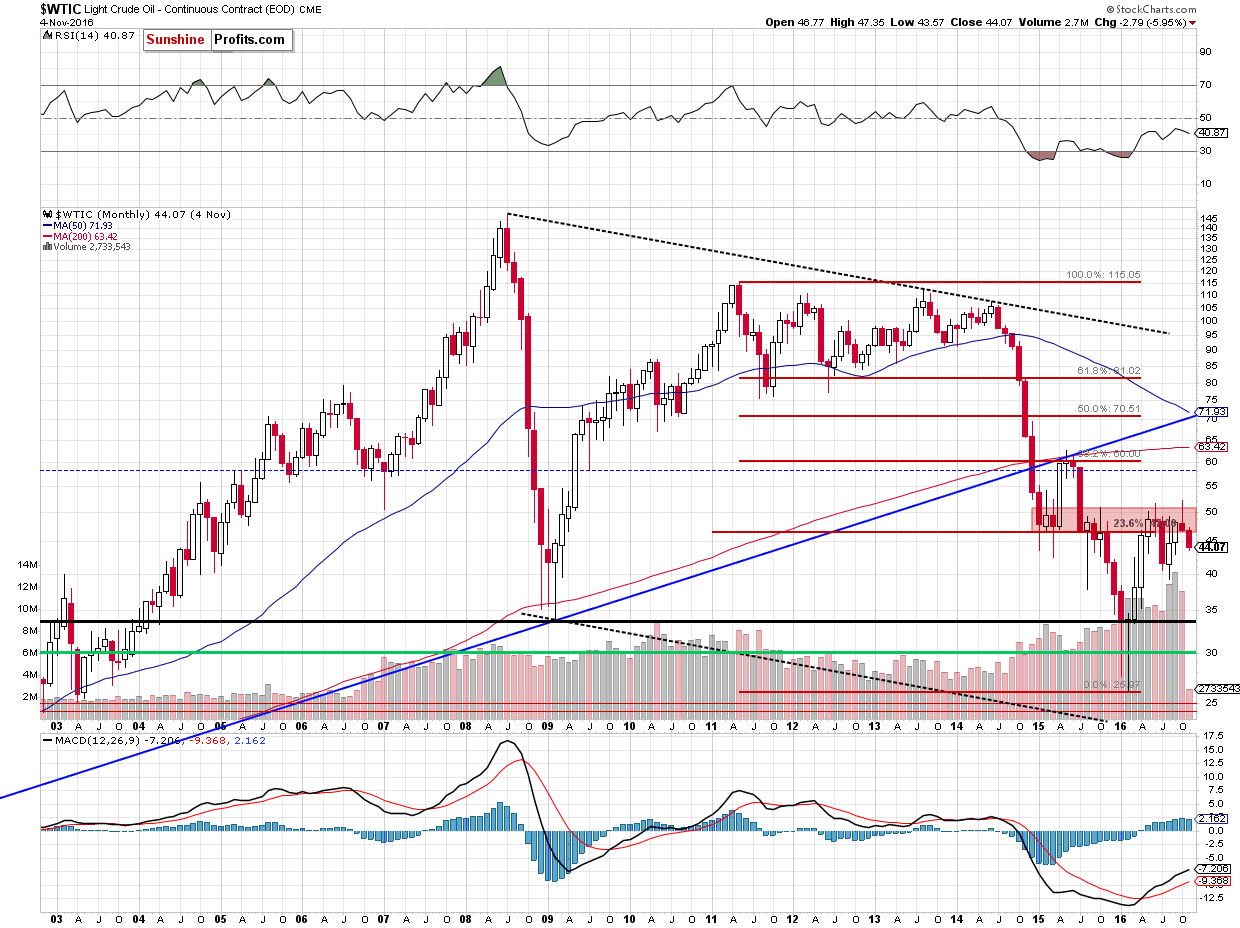
The first thing that catches the eye on the long-term chart is an invalidation of a small breakout above the red resistance zone. As you see this negative event triggered further deterioration earlier this month, which resulted in a drop below the red area.
How did this move affect the medium-term picture? Let’s examine the weekly chart and find out.
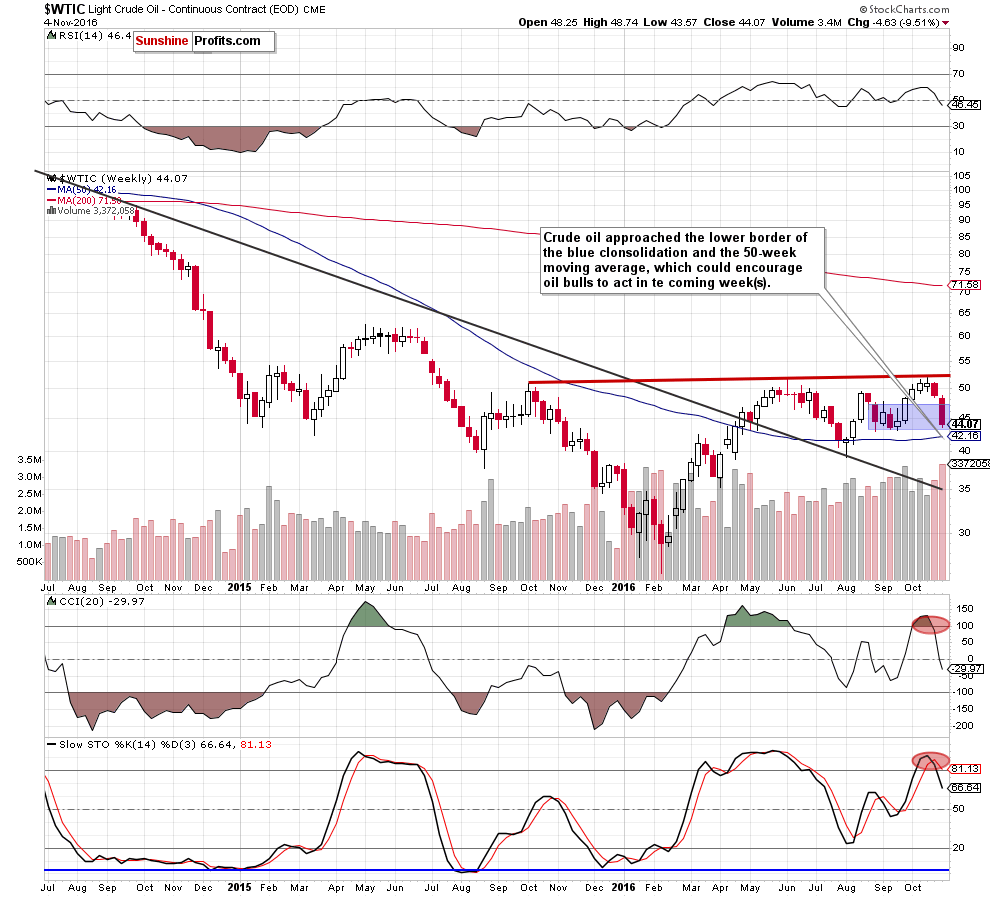
A month ago, we wrote the following:
(…) when we focus on the weekly chart, we notice that the last week’s volume was much smaller compared to what we saw a week earlier, which suggests that oil bulls may run out of steam. If this is the case, a reversal and correction from current levels should not surprise us.
Looking at the above chart, we see that the situation developed in line with the above scenario and crude oil reversed in the previous month. Thanks to this drop, light crude came back to the blue consolidation, invalidating earlier breakout. This negative event encouraged oil bears to act, which resulted in further deterioration and a drop to $44. With this downward move, light crude approached the lower border of the blue consolidation and the 50-week moving average, which could encourage oil bulls to act and trigger a rebound in the coming week.
Are there any other technical factors that could support such price action? Let’s take a look at the daily chart and find out.
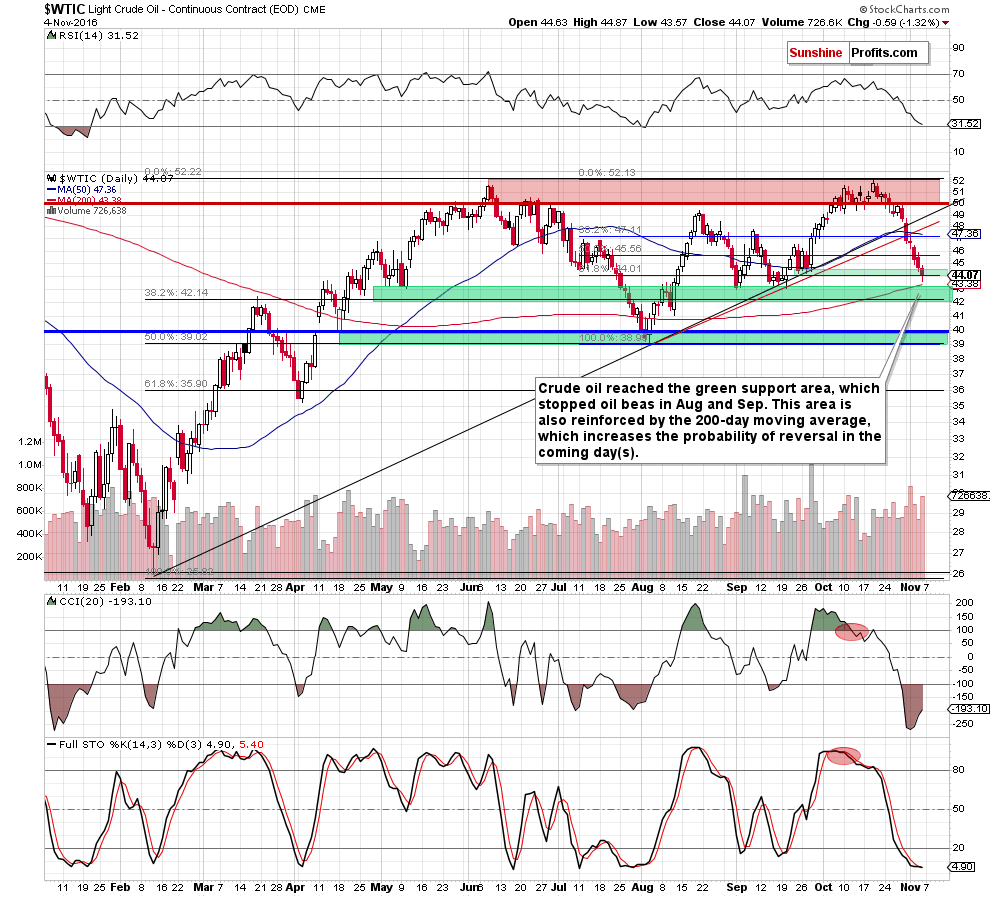
An invalidation of the breakout above the barrier of $50 triggered a decline not only below the red support line based on the Aug and mind-Sep lows, but also under the black rising support line based on the Feb and Aug lows. With this decline, crude oil moved under the 50-day moving average and the 50% Fibonacci retracement (based on the Aug-Oct upward move), which resulted in a test of the support zone created by the late-Sep lows and the 61.8% Fibonacci retracement around $44.16).
What’s next? Taking into account the fact that there are still no buy signals at the moment, it seems that crude oil could decline even to the next (and much stronger) support zone created by the 38.2% Fibonacci retracement (based on the entire Feb-Oct upward move), late Apr and early May lows, early Aug highs and Sep lows. This area is also supported by the 200-day moving average, which increases the probability of reversal and bigger rebound (in our opinion, to around the previously-broken red and black support/resistance lines) in the coming week.
Nevertheless, it’s worth keeping in mind that there is a negative divergence between the CCI and the price, while the Stochastic Oscillator dropped to its lowest level since early Aug. Back then similar situation encouraged oil bulls to act, which resulted in a rally above $49. Therefore, the probability of reversal in the coming days is increasing.
Summing up, crude oil extended losses and approached important resistance zone, which could encourage oil bulls to act – similarly to what we saw two times in Sep. Additionally, the current position of daily indicators suggests that the space for declines is limited and reversal is just around the corner.
Having discussed the situation in crude oil, let’s examine the NYSE Arca Oil Index (XOI) to find out what the current outlook for oil stocks is.
Oil Stocks
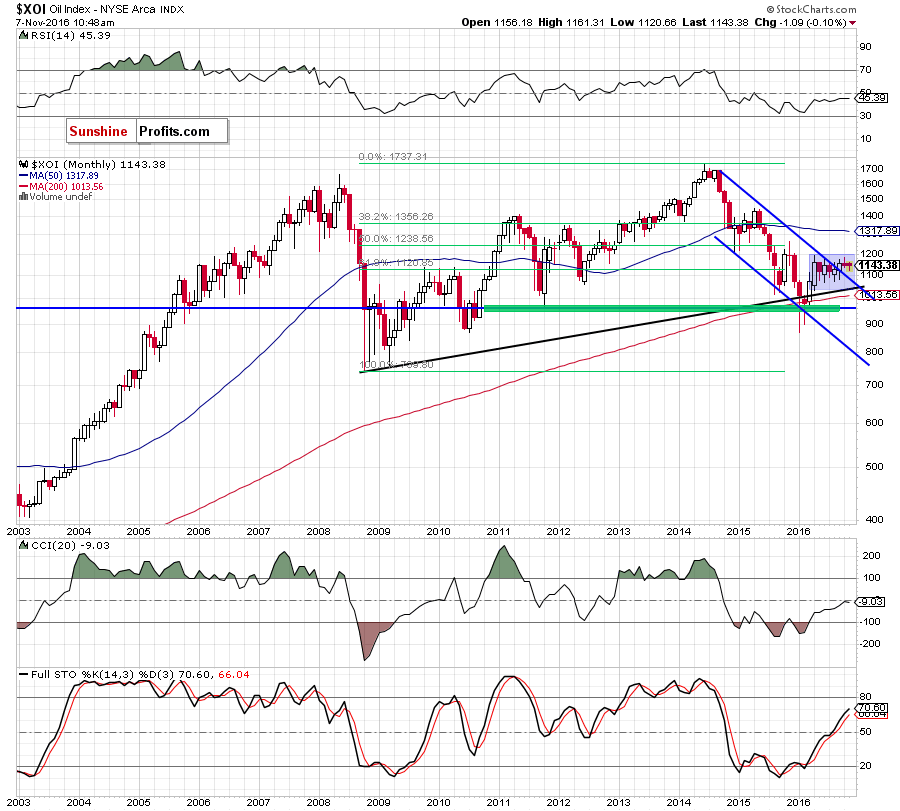
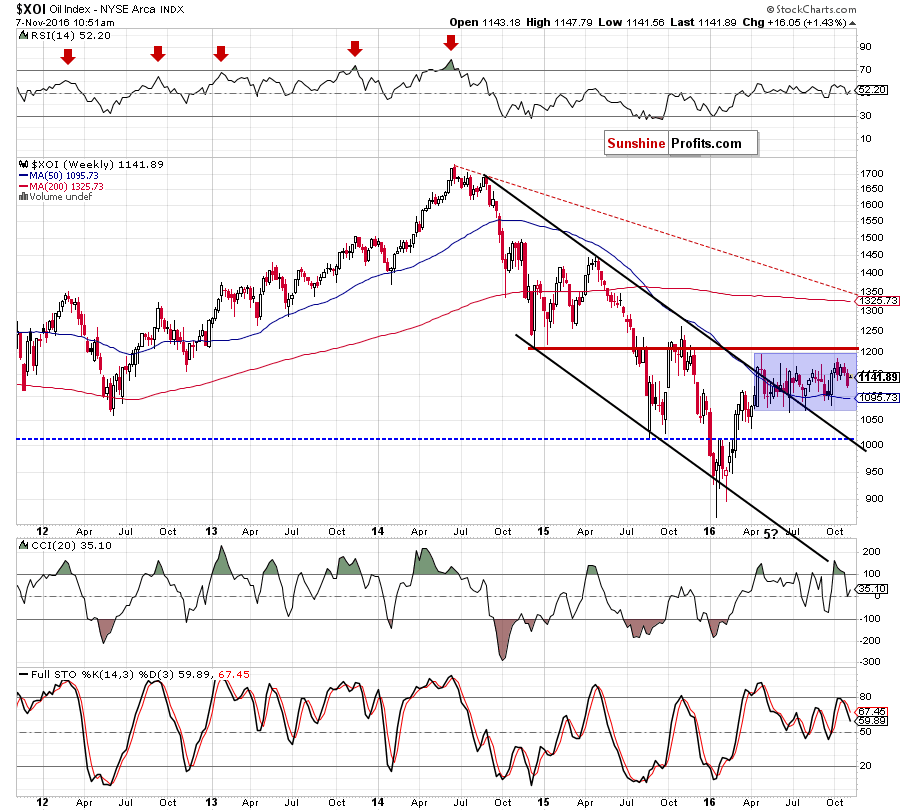
The situation in the long- and medium-term perspective remains almost unchanged as the XOI is trading in a blue consolidation between the upper border of the black declining trend channel (seen on the weekly chart) and the Jun and Jul highs. This means that as long there won’t be a breakout above the upper line of the formation (or a breakdown under the lower border of consolidation) another bigger move is not likely to be seen.
Having said the above, let’s examine the daily chart.
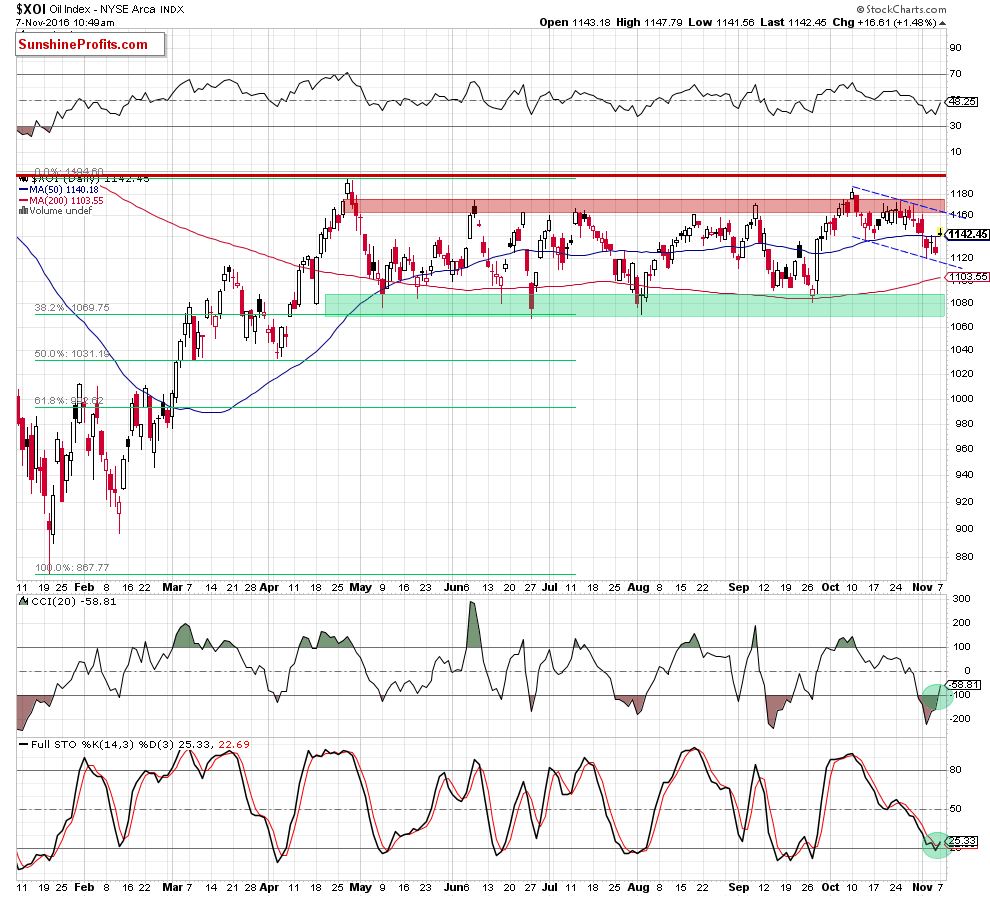
Quoting our previous update:
The first thing that catches the eye on the daily chart is a breakout above the upper border of the red resistance zone. Although this is a positive signal that suggests further improvement, we should keep in mind that slightly above the current levels there is another resistance zone based on the Apr highs. On top of that, when we focus on the position of the indicators, we see that the CCI and Stochastic Oscillator are overbought and very close to generating sell signals, which suggests that the space for gains is limited. If this is the case, oil stocks will reverse and invalidate yesterday’s breakout above the red zone. If we see such price action, it would be a bearish signal, which will likely accelerate further deterioration in the following days.
How low could the XOI go in the coming week(s)? In our opinion, the initial downside target would be around 1,133-1,135, where the 50-day moving average and the Sep 22 high are.
From today’s point of view, we see that oil bears pushed the index lower as we had expected. Thanks to this drop, oil stocks not only slipped to our initial downside target, but also reached the lower border of the blue declining trend channel. As you see, this support in combination with buy signals generated by the indicators encouraged investors to act, which resulted in a comeback above the 50-day moving average and invalidation of earlier breakdown. What’s next? Taking this positive event into account, we think that the XOI will extend gains in the coming days, which will likely result in a test of the upper border of the trend channel and the red resistance zone.
Summing up, although oil stocks declined in the recent weeks, the lower border of the blue declining trend channel stopped oil bears and triggered a rebound, which invalidated earlier breakdown under the 50-day moving average. Taking this positive even into account and combining it with buy signals generated by the indicators, we think that oil stocks will come back to the red resistance zone (around 1,164-1,174) in the coming week(s).
Ratio Analysis
Today, we start this section by focusing on the oil-to-oil stocks ratio. What can we infer from the chart below?
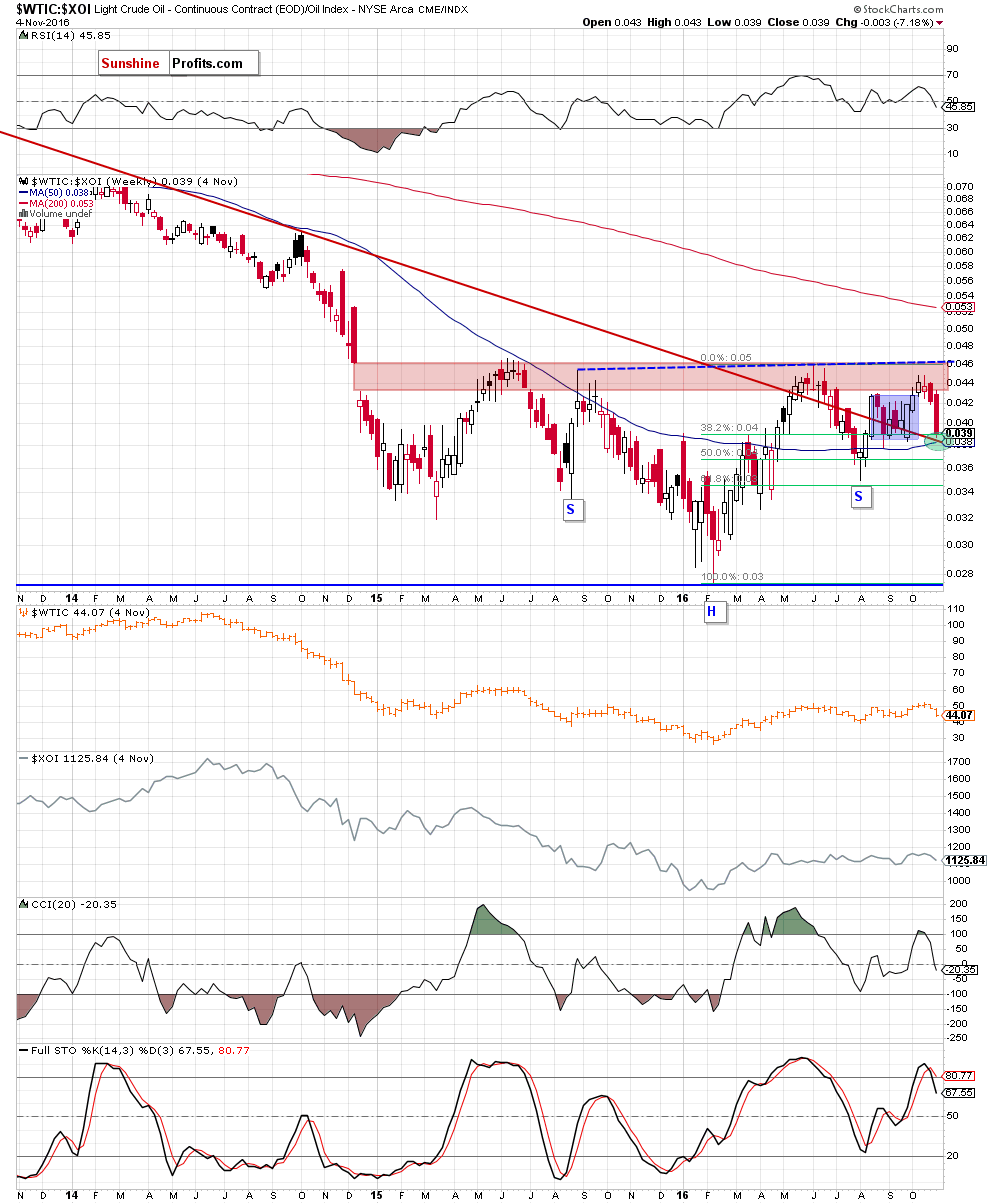
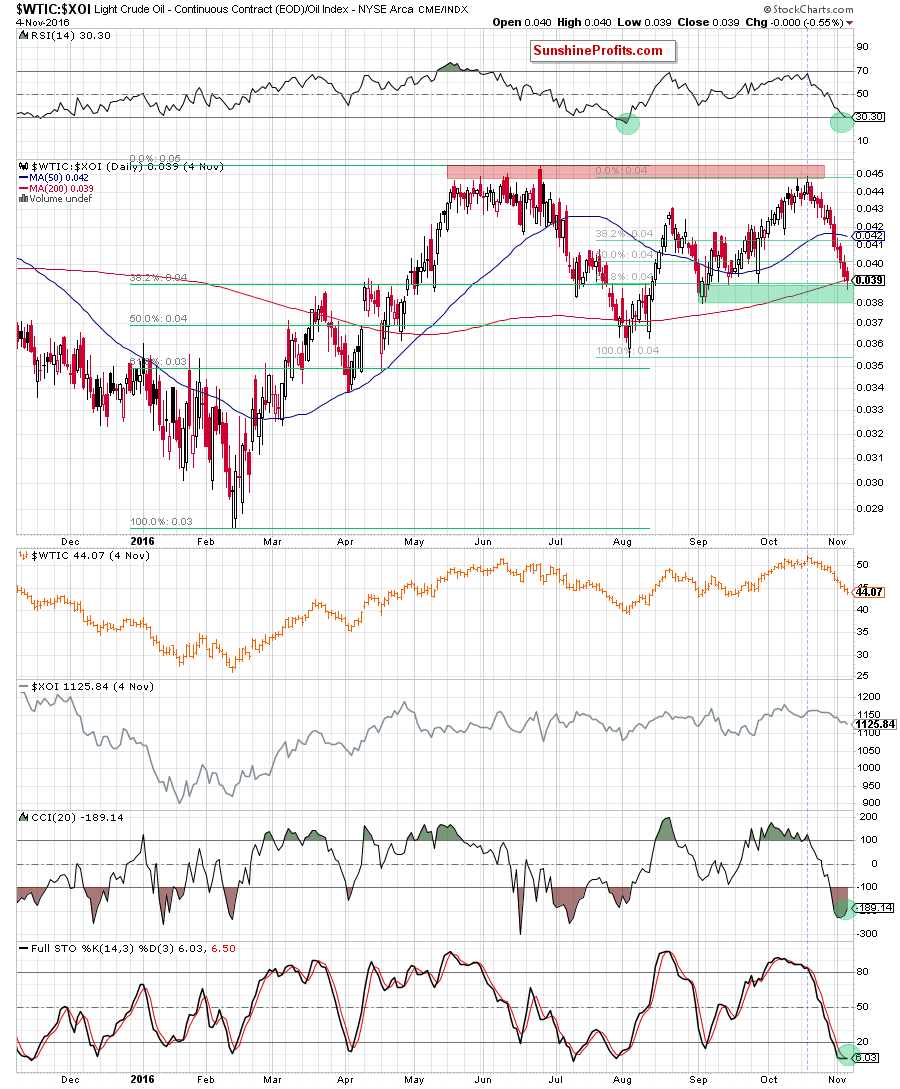
A month ago we wrote:
(…) the key red resistance zone (based on the Dec 2014 gap) continues to keep gains in check. Therefore, (…), as long as there won’t be a breakout and a weekly closure above the upper border of the zone (which is currently reinforced by the neck line of a potential reverse head and shoulders formation) further rally is not likely to be seen and another reversal is very likely (not only in the case of ratio, but also in the case of crude oil as strong positive relationship remains in play).(…) the ratio stopped in the red resistance zone based on the previous highs seen on the [daily chart]. On top of that, there are negative divergences between indicators and the ratio and Stochastic Oscillator generated a sell signal, suggesting an attempt to move lower in the coming days.
Looking at the above charts, we see that the situation developed in tune with our previous assumptions and the ratio has declined. As you see this downward move took the ratio not only to the green support zone (created by the Sep lows, the 200-day moving average), but also to the long-term red declining support line. This means that if we see a rebound from here, it may be a verification of earlier breakout above the red line, which will likely translate into higher values of the ratio in the coming week(s). Additionally, all daily indicators declined to levels not seen from early Sep, which increases the probability of reversal. Connecting the dots, if the ratio moves higher from current levels, we’ll also see a rebound in the case of crude oil as a strong positive correlation remains in play.
Will the oil-to-gold ratio confirm this pro-growth scenario? Let’s check the chart below and find out.
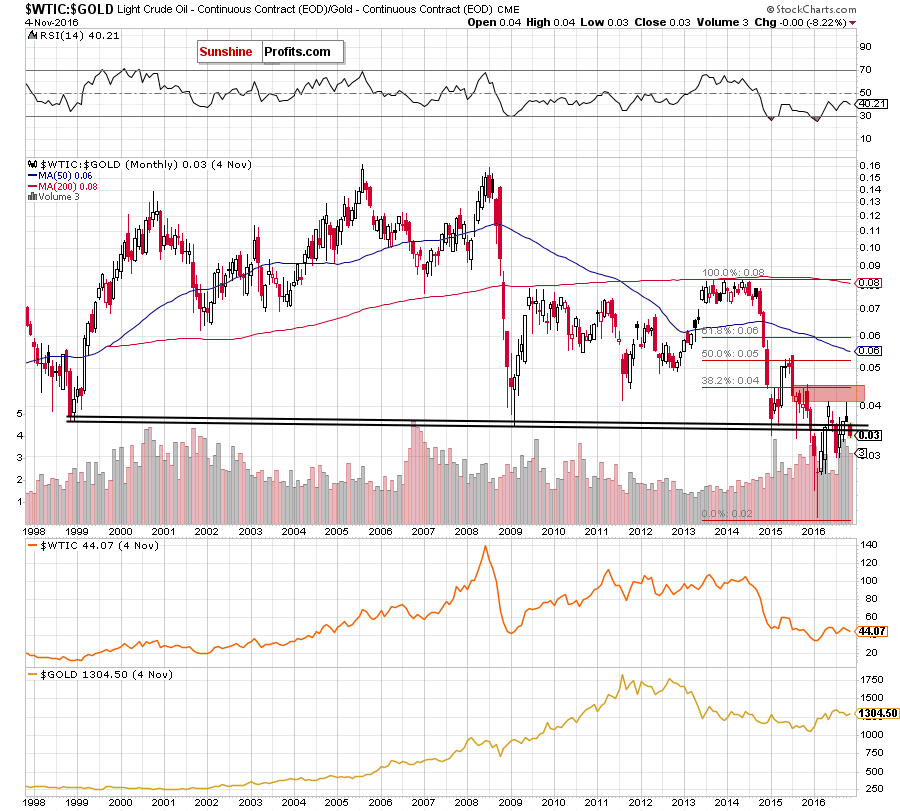
On the long-term chart, we see that the red resistance zone stopped further improvement, triggering a decline, which took the ratio under the previously-broken black support/resistance lines (a negative signal, however, as long as there is no monthly closure below them another rebound is likely).
How did this move affect the medium-term picture? Let’s check.
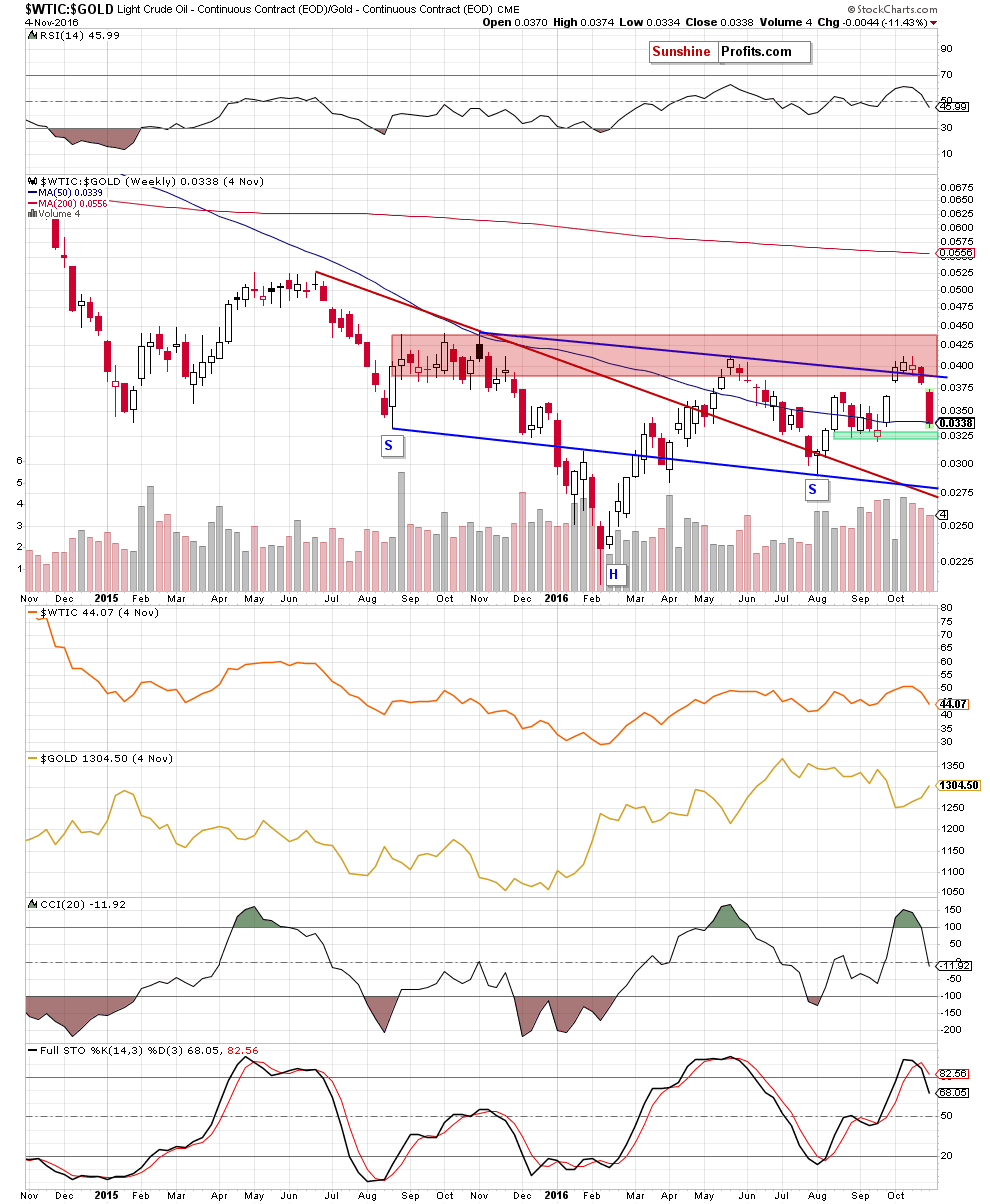
From today’s point of view, we see that the red resistance zone encouraged bears to act, which resulted in a drop below the previously-broken blue support line (a neck line of a potential reverse head and shoulders formation). This negative event triggered further deterioration and the ratio slipped to the 50-week moving average, approaching the green support zone.
Additionally, all daily indicators dropped to the levels not seen from Aug, which increases the probability of reversal.
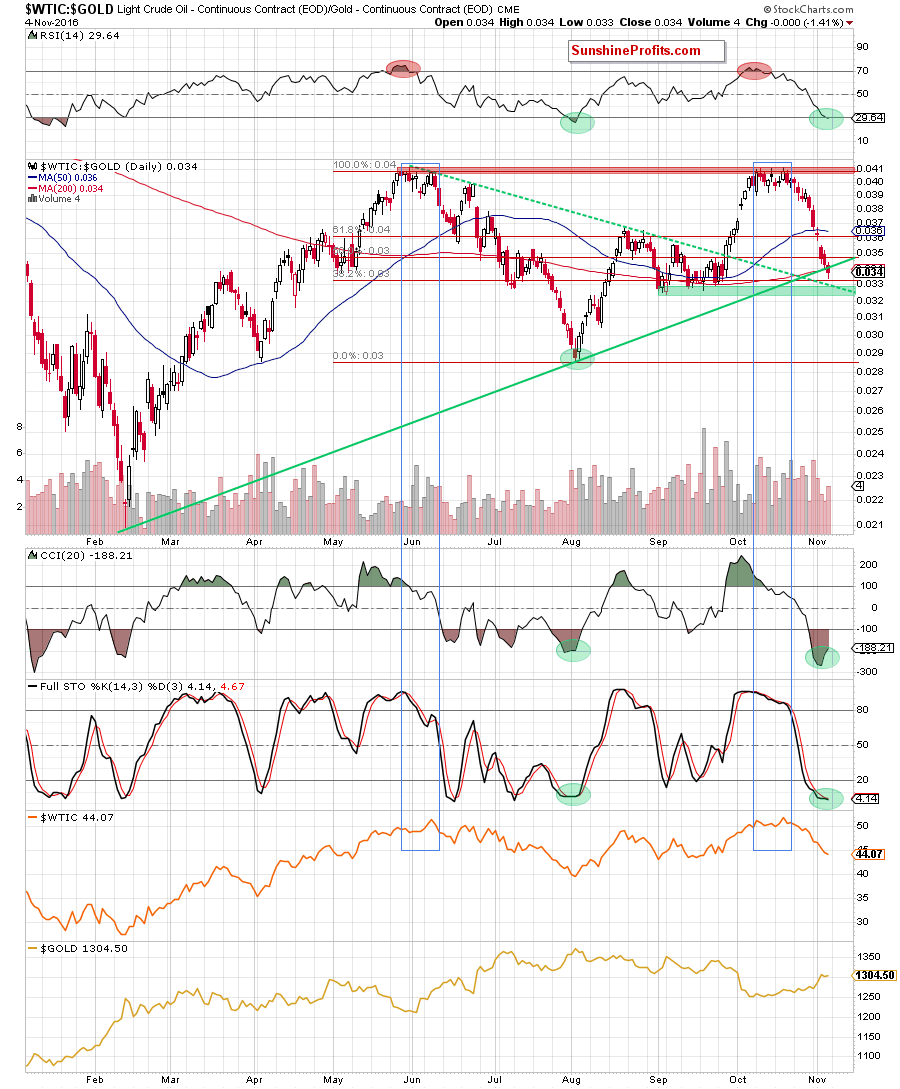
What can we expect in the coming days? Taking into account the proximity to this important support zone and the current position of the indicators (the RSI slipped below the level of 30, the CCI is extremely oversold and there is a positive divergence between it and the value of the ratio, while the Stochastic Oscillator is very close to generating a buy signal), we think that reversal and higher values of the ratio are just around the corner. What does it mean for crude oil? Taking into account a strong positive correlation between the ratio and the commodity, we think that higher prices of black gold are very likely in the coming week(s).
Once we know the above, let’s take a closer look at the relation between oil and the general stock market.
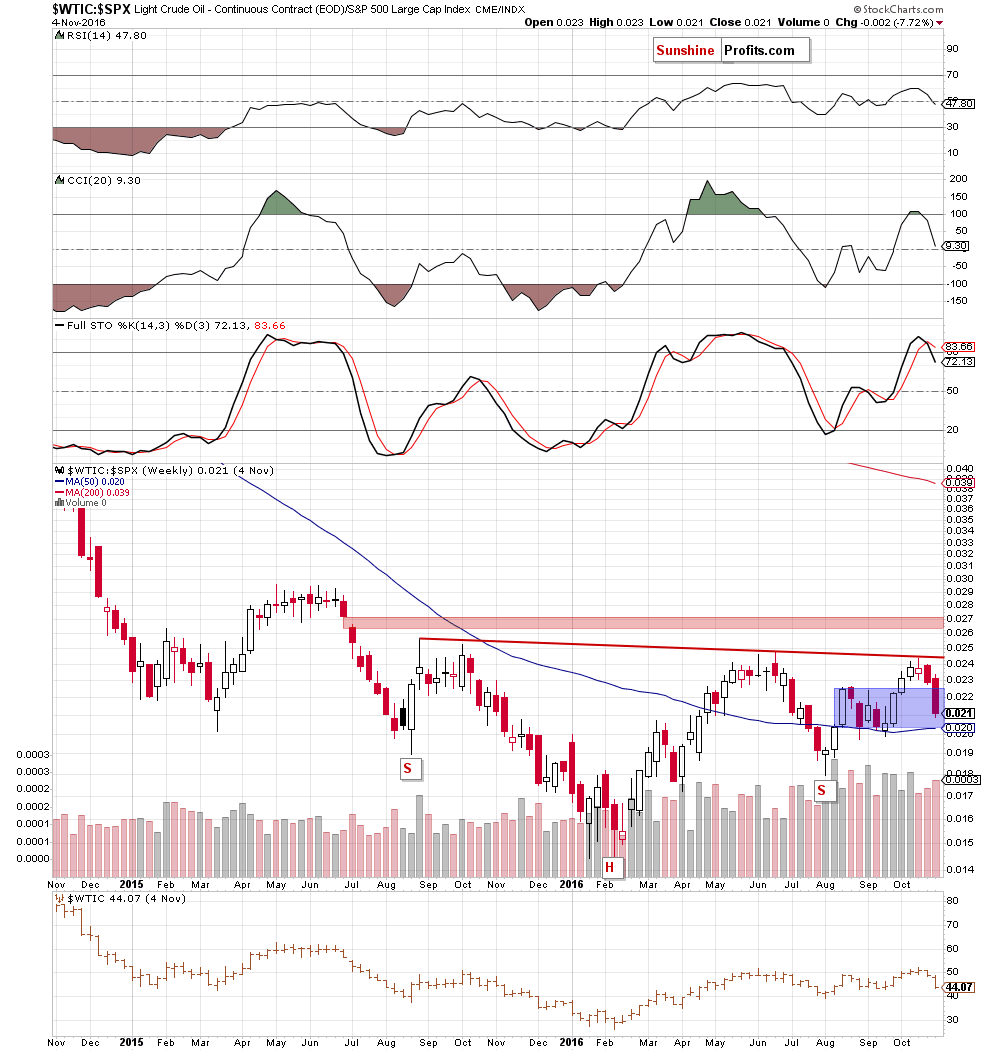
On the weekly chart, we see that the red resistance line based on the Aug 2015 and Jun 2016 highs triggered a decline, which took the ratio to the blue consolidation (an invalidation of a breakout, which is a negative signal).
What impact did this drop have on the very short-term chart? Let’s check.
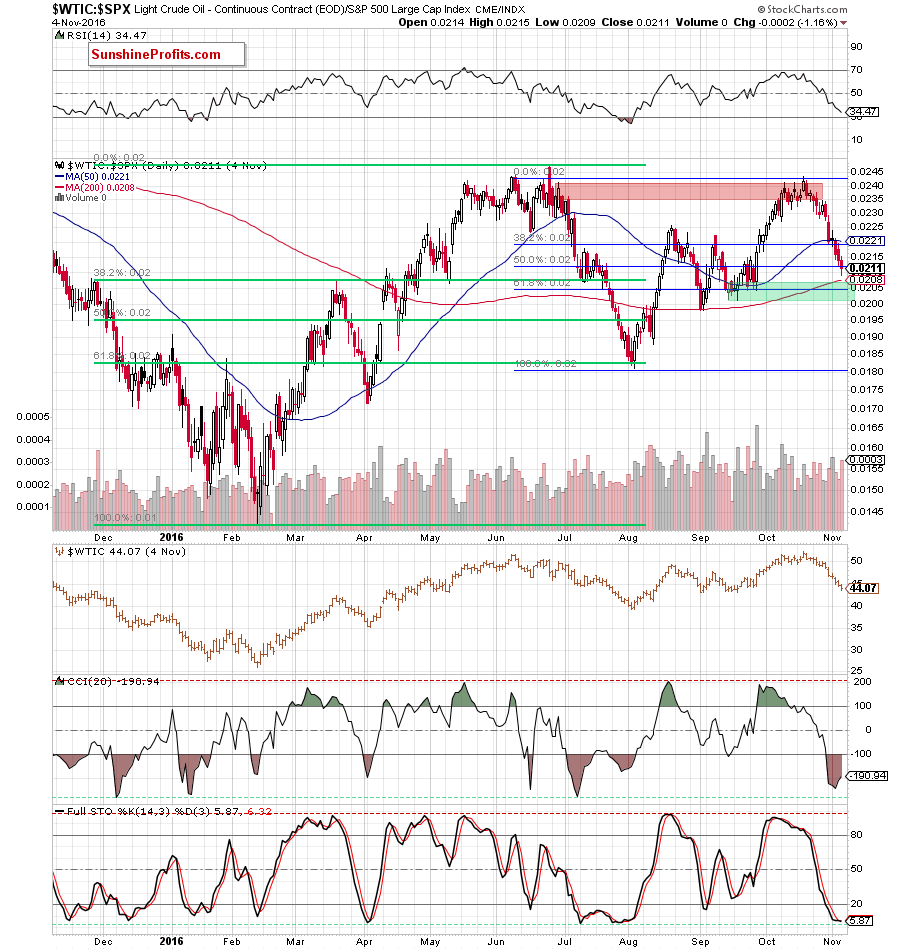
From the daily perspective, we see that the red resistance zone in combination with sell signals generated by the indicators and the medium-term picture encouraged bears to act, which resulted in a decline to the 50% Fibonacci retracement. Thanks to this drop, the ratio approached the green support zone created by the Sep lows and reinforced by the 200-day moving average and the 61.8% retracement, which suggests that the space for declines may be limited – especially when we factor in the current position of the indicators (a positive divergence between the CCI and the ratio, the RSI slightly above the level of 30 and the Stochastic Oscillator at its lowest level since months). Taking all the above into account, we think that higher values of the ratio (and also crude oil as strong positive correlation remains in cards) should not surprise us in the coming week(s).
Non-USD Crude Oil Price
Finishing our today’s ratios’ analysis, let’s take a closer look at the non-USD (WTIC:UDN ratio) chart of crude oil. As a reminder, UDN is the symbol for the PowerShares DB US Dollar Index Bearish Fund, which moves in the exact opposite direction to the USD Index. Since the USD Index is a weighted average of the dollar's exchange rates with world's most important currencies, the WTIC:UDN ratio displays the value of crude oil priced in "other currencies".
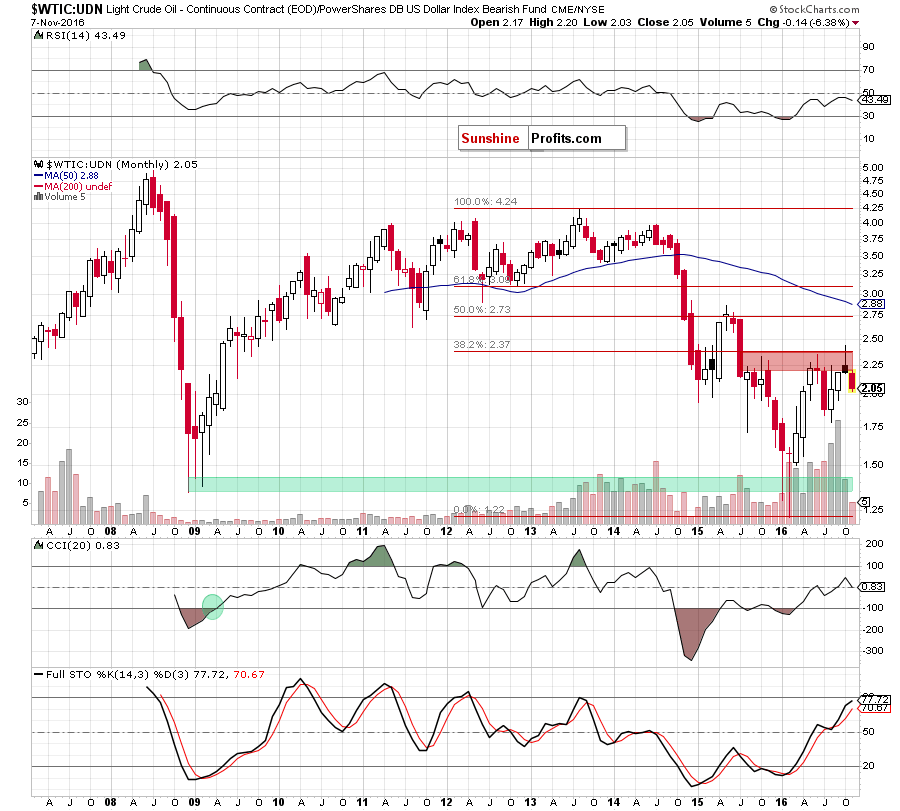
On the monthly chart, we see that although the ratio increased slightly above the red resistance zone and the 38.2% Fibonacci retracement, this improvement was only very temporary. As a result, we saw a decline and a drop below the red zone.
How did this move change the medium-term chart? Let’s check.
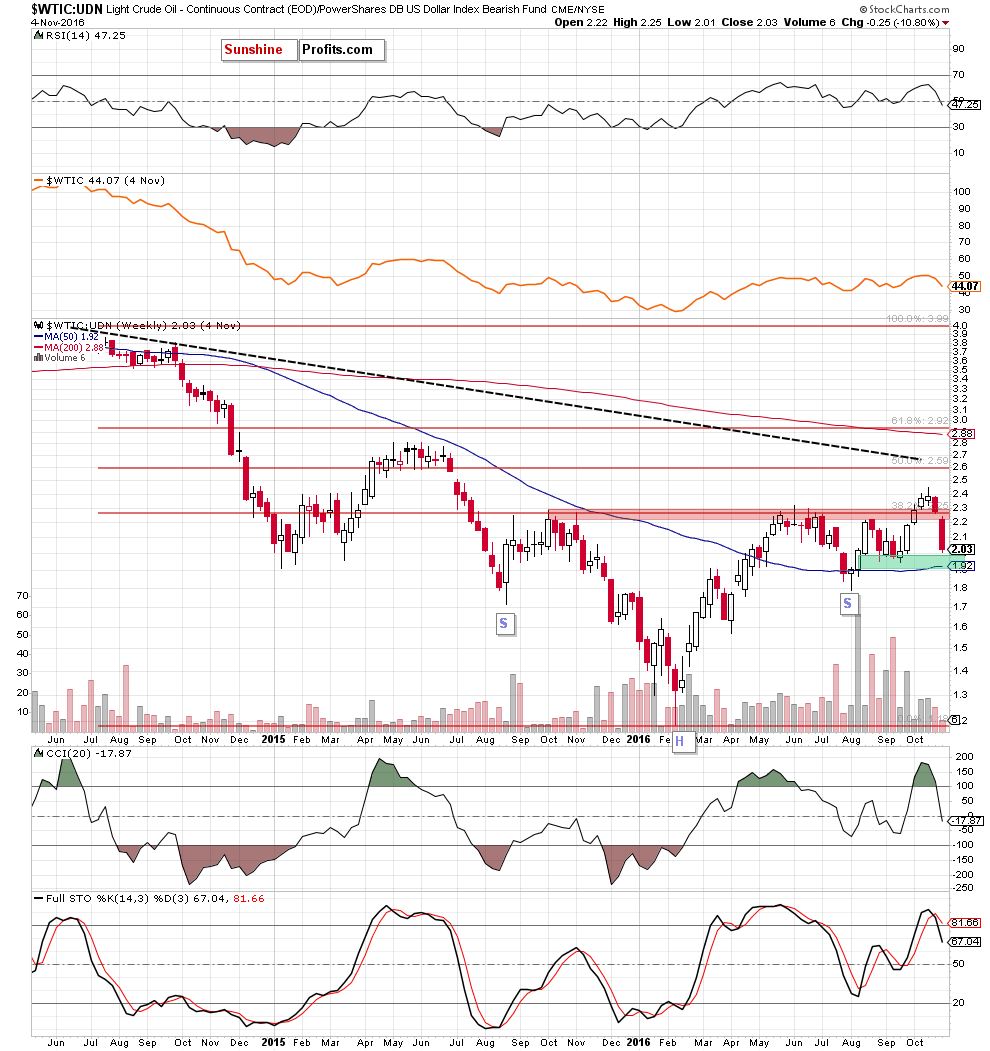
From this perspective, we see that the ratio moved sharply lower and approached the green support zone in the previous week, which (similarly to what we wrote in the case of the oil-to-stocks ratio) suggests that the space for declines may be limited and reversal is just around the corner. This scenario is also reinforced by the current position of the daily indicators (seen on the chart below) and the proximity to the 200-day moving average.
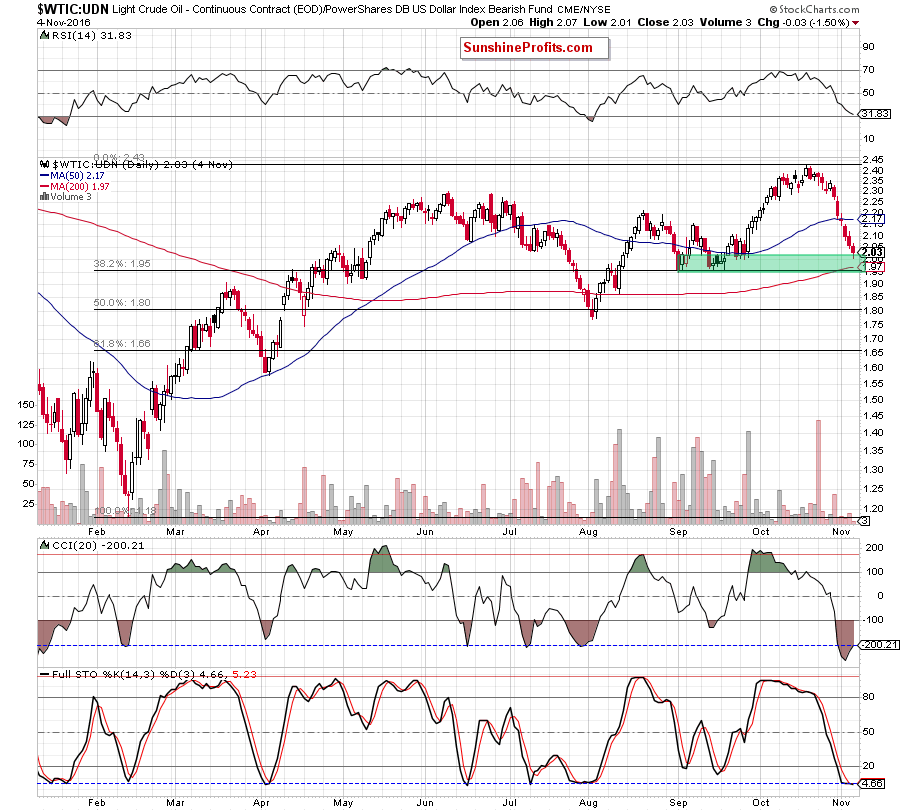
Scenarios
Just like a month ago, today’s Oil Investment Update includes scenarios of what could happen in the coming weeks. Naturally, we will continue to monitor the market in the coming days and if anything invalidates our long-term outlook we will send you an additional message.
- Bullish scenario
If crude oil bounces off the green support zone marked on the daily chart, we’ll see a rebound to around $47.36-$48, where the previously-broken 50-day moving average and the red support/resistance line (based on the Aug and mid-Sep lows) are. If this area is broken, the next targets would be: the medium-term black rising support/resistance line based on the Feb and Aug lows (currently around $48.84), the barrier of $50 and the 2016 high of $52.22, which together create the red resistance zone marked on the daily chart. If oil bulls manage to break above this key resistance zone, the next upside target would be around $60-$62.58, where the 38.2% Fibonacci retracement (based on the entire 2011-2016 downward move), May and Jun 2015 highs are. - Bearish scenario
If the commodity drops under the green support zone based on the Sep lows (and reinforced by the 200-day moving average), we’ll see a test of the barrier of $40 and the next green support zone (created by the Aug lows and the 50% Fibonacci retracement) slightly below it. If oil bears manage to push the commodity under this key support zone, the next downside target would be around $35.24-$35.90, where the Apr lows and the 61.8% Fibonacci retracement are.
Summary
After three weeks in the consolidation in the red resistance zone (between the barrier of $50 and the Jun highs), oil bears accumulated enough strength to push the commodity below the barrier of $50, triggering a decline that erased almost all mid-Sep – Oct upward move. Although such price action doesn’t bode well for crude oil, we should keep in mind that not only crude oil, but also the oil-to-oil stocks, oil-to-gold, oil-to-stocks and the WTIC:UDN ratio reached their important support zones. Additionally, the current position of the daily indicators (not only in the case of crude oil, but also in the case of all our above-mentioned ratios) suggests that the space for declines may be limited as they slipped to the levels not seen since Aug or Sep and there are positive divergences, which increase the probability of reversal in near future. Therefore, if we see such price action, and crude oil rebounds from current levels, we’ll see an increase to (at least) the first upside target from our bullish scenario in the coming week(s).
Very short-term outlook: mixed with bullish bias
Short-term outlook: mixed
MT outlook: mixed
LT outlook: mixed with bearish bias
Trading position (our opinion): No positions justified from the risk/reward perspective.
This completes this month’s Oil Investment Update. Our next Oil Investment Update is scheduled for Monday, Dec 5, 2016. Oil Trading Alerts subscribers will additionally receive similar but shorter alerts on a daily basis (or more than once a day when the situation requires it). You – Oil Investment Updates subscribers – will receive short Investment Alert messages should the outlook for the medium or long term change before the next Update is posted.
Thank you.
Nadia Simmons
Forex & Oil Trading Strategist
Oil Investment Updates
Oil Trading Alerts



